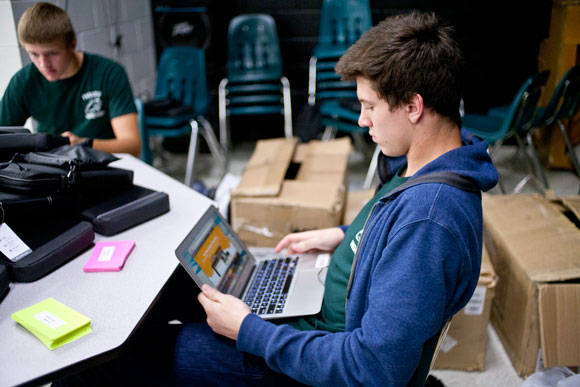I’ve been a high school social studies teacher for over two decades. If you’re reading this, then you have likely been to the same professional development seminars and programs I have attended over the last few years. You’ve likely learned about many of the amazing things digital devices can do in the classroom. You’ve been trained in how to set up your Google classroom, how to flip your classroom and how to blend learning. You’ve been introduced to using Twitter, Snapchat and Instagram in your lessons. You might have even attended a session on how to Skype with students from across the world. Those things sound fantastic – and they are. The issue is not what can be done with many of today’s digital devices and apps. The issue is what students are doing with these digital devices and apps, in school in general and in the Social Studies classroom in particular.
We know kids are not great at impulse control. We know their brains are not yet fully developed. We know they are not great at delaying gratification. We know teens are now spending an average of nine hours per day consuming entertainment and social media screen time[i]. Yet in schools, the answer seems to be to encourage more screen time. No reasonable person could possibly think that having an Alcoholics Anonymous meeting in a bar is a good idea. Some might say, “well, alcohol is everywhere in our culture, so people with drinking problems are going to have to learn how to control themselves, so having our meeting in a bar makes sense.” That’s simply not a realistic expectation – for adults. Why then would it be a realistic expectation to give children devices that hold infinite, free entertainment possibilities and expect them to use them productively – without the closest, most careful guidance, and extremely targeted goals? It isn’t, and that is not typically what is happening. Fire, similarly, can do many productive things. But we don’t force children to play with it.
Yet schools force kids to spend more of their day on screen than they otherwise would. When we require students to use online textbooks, rely on Google classroom and apps, check assignments on Blackboard and turn things in to a digital drop box, we are forcing them to be on screen. That time, designed to be educational, presents an unfair temptation to a kid, which more often than not results in that kid falling down the rabbit hole of social media, YouTube, Netflix, videogames and/or pornography.
A mother of two high school aged girls recently contacted me to share this story. Her daughter’s school one day administered a school-wide training on sexual harassment. Important information and stories were shared with all boys and girls in the school. Students took a brief quiz to show they understood the concepts. The next day this mom’s daughter was in history class. A boy in her class airdropped pornography to her. She asked him to stop and he continued to do it.
I obviously don’t mean to say that every kid was doing this, or even to say this is what happens in all cases. However, it is illustrative of the difficulties kids have in controlling their impulses when given powerful devices that can endlessly amuse and enchant. Imagine being sixteen and in high school. Imagine your school giving you a device (or your teachers encouraging you to use a device) that gave you access to unlimited, free movies, tv shows, amusing videos, video games, social media and pornography. Now imagine your history teacher telling you to go home, use the device to read about the Maurya Dynasty in your online textbook, and then watch a screencast of him or her teaching about Asoka. Would you have chosen that, or the unlimited, free entertainment? Before you answer, think of the last faculty meeting you attended. How many adults in the room were ignoring the meeting in favor of paying attention to their phone or laptop? Those are adults. Now think again about what you would have chosen as a kid. I’m with you.
Matt Miles and I wrote Screen Schooled because we saw things changing for the worse in our classrooms. We watched over the years as students increasingly struggled with problem solving, critical thinking, focus, and social interaction. For instance, each year, starting in the mid-1990s, I worked with my US Government students on a Socratic Seminar about James Madison’s seminal and notoriously difficult Federalist 10. Students would read and annotate the piece at home and come prepared with questions and observations. Overall, they struggled but persevered, and were richly rewarded. They were proud of the fact that they had taken on a challenging piece of historical writing that would befuddle many adults. They made connections to the America in which they live and left class with a deeper understanding of who they are, and who we are as a people. They wrestled with issues like majority rule, minority rights, free association and the purpose of political organization. These were “RK’s” – Regular Kids; not AP or Honors kids. In fact, for a few years I did the lesson in team taught LD Government classes, and had much the same results. As the years went by, though, things began to change. The discussion was less robust. The number of kids who had not read the piece grew to the point that the seminar fell flat. Eventually, I changed tactics and had kids read it in class. To my dismay, things continued to deteriorate. In response to a question like, “to what extent have we heeded Madison’s warnings about political parties?” I would get copied and pasted recitations from Wikipedia’s entry on what Madison thought about political parties. When I asked questions purely about their opinions – “explain which is more important for America today – to pay attention to the will of the majority, or to protect minority rights” I would get either one phrase answers with no analysis, or I would get a definition of what majority rule and minority rights are. A few years ago, I stopped doing the lesson – and I was teaching Honors Government classes – comprised of some of the most capable students in the school.
Is the demise of my Federalist 10 seminar solely the fault of screen overuse? Probably not. But it’s clearly a factor. The more kids have access to devices that can immediately answer questions, the more they turn to those devices to answer the questions. Those become their answers and, more frighteningly, their thoughts. Further, I have been told – and I’m guessing you have as well, in one way or another – that kids having knowledge is no longer important. In content-rich Social Studies courses, that’s quite a statement. The issue, of course, isn’t that it’s critical that kids know the Battle of Hastings was in 1066. Knowing what happened, though, what it means in the broader context of British and world history, and how it is related to subsequent events is a different matter altogether. Further, when we – kids in particular — outsource our knowledge we run the increasing risk of becoming “meta-ignorant”[ii] – unaware of what we don’t know. That’s dangerous – just ask anyone who has survived life in a country under dictatorial rule. A political science teacher I know told me recently what happened when his students showed up for their first day on their internships. Every one of them came back dismayed that their supervisors wanted them to know things. They were expected to know about the political system for sure, but they were also expected to know and have life skills – how to answer phones, how to shake hands and look people in the eye when talking with them. They went on to explain that in their world, they text or use the social media app of the moment to communicate. It’s just easier, they explained. It’s not clear that unfettered screen access is making these young people better citizens. So why are we pushing it in schools?
As adults we set limits of all kinds for our kids. We limit the amount of sugar they eat, the movies they see, and the activities in which they engage. Except this one. For some reason, we seem to think that as long as it’s on screen and they’re inside that kids are “safe.” They’re not. In addition to the academic challenges presented by screen overuse, the risks for bullying, anxiety, social isolation and depression are all far higher for heavy screen users,[iii] which nearly all kids are. Like it or not, when we make kids do everything on Google, read online textbooks, flip our classrooms, ask them to do webquests, watch TED talks and Kahn Academy, and watch us teach about Asoka, what we are doing is increasing their screen usage. And there is scant data suggesting it is helping them learn. Further, it increases the likelihood they are going to be on social media, Netflix, videogames and porn. They cannot control themselves so we have to do it for them.
What would that look like? It surely does not mean standing up and lecturing from bell to bell every day. We all know that there is no one technique – no magic teaching bullet – that should be employed one hundred percent of the time. All good techniques – screen-based or not – are a part of a rich tapestry employed by successful teachers. I would guess that most proponents of educational technology would agree. However, this is another time where we need to consider what is happening, not just what we hope is happening. Teachers today are encouraged to use ed-tech as often as possible. Project RED, of the one-to-one computing initiative, says their research shows that students must use computers in school every day in order to gain[iv]. No surprise that the sponsors of that research are Intel, Pearson, HP, and Smart Technologies. The bottom line is that whatever techniques a teacher uses should be rooted in enduring, effective principles. Three of the best are that lessons and techniques are simple, skills-based, and social.
If a lesson depends on 30 devices and a school network in order to work, we’re asking for trouble. What we must ask ourselves is, does this lesson need computers? Is it better because of the introduction of a screen? If the answer is yes, then that sounds like a good reason to use the device. Many times, though, the answer is no, and we just use the screen because it is there, or because we think the kids will like it better, or because we are being evaluated this year and our administrator likes it when we use the school’s expensive gadgets.
Two US history teachers at a nearby high school told me of this experience. One teacher decided he was going to use his school’s educational-technology tools to design a lesson on historical political cartoons. He created a very good thirty-minute PowerPoint presentation of cartoons, and he reserved a mobile laptop cart for students. He wove in a Google Doc and had students comment on the cartoons. He was thrilled that he got comments from students who didn’t typically participate in class.
At the end of the day, he spoke with another teacher who was doing a similar lesson, using cartoons from the same time period. However, she had printed copies of the cartoons and affixed them to large sheets of newsprint she had posted around the room. At her prompt, students got up and walked around the room, reading the cartoons and making curriculum-related comments on the newsprint. This lesson took her about fifteen minutes to prepare. The teacher using the screen-based version decided imitate the other lesson and see if there was a difference.
The difference was he took a good lesson and made it great. The simple act of having students get out of their chairs served to energize the classroom and the discussion. Having students walk from cartoon to cartoon meant they had to interact with one another. He heard content-related discussion happening as the students were writing. When he had students commenting on Google Docs, the room was silent and students were intently staring at their screens. This version still drew commentary from students who do not typically comment in class discussions. It enabled him to stand near a cartoon and interact with a small group of students who were working on it. More students were engaged, and they were more engaged than before. In short, this lesson was superior in nearly every way compared to the more complex technology-enhanced lesson.
The first advantage of simplifying lessons is that we know they’ll work. More important, however, is that we’re making it easier for students to understand what to do. Simple lessons are also flexible lessons. They can be done in a classroom or on the bus during a field trip. Sometimes, we complicate our lives unnecessarily and inadvertently put up road blocks for our students.
A second enduring principle for our lessons is that they should be skills-based. In the Social Studies classroom, it is easy to get caught up in hammering home content – especially in an era of high-stakes testing. However, content is meaningless unless students do something with it. In Government classes, we want our students to know what is in the Constitution, of course. However, unless they’re going to use that information they might as well just look it up on their phones. If students can analyze, for example, what natural rights are most protected in our society today and which ones are most under attack, then their knowledge of what is in the Constitution has meaning.
Finally, our lessons need to encourage social interaction. Kids often substitute group chats on their phones for actual group activities. Whenever possible we need to get our kids talking with one another and working together. “Collaborating” on a Google doc is not really collaborating. Being physically together and talking, reading body language and facial expression, mediating differences of opinions in real time, sharing in “aha!” moments as they happen – those are things that can rightly be called collaborating. Two people in their own, separate homes making changes to a shared document are not truly collaborating. “Soft skills” like negotiating and being a convincing communicator are prized in any field in which a student might end up working.
The world beyond education, it seems, is waking up to the damage screen overuse is doing to kids. Cellphones have been banned in schools in the entire nation of France. An investment group holding over $2 billion in Apple stock has demanded that Apple do more to stem screen addiction among kids. Facebook’s new app, targeted at the under-13 set, has been assailed in a public letter from child advocates from across the globe. Every day brings more news about negative physical and mental health outcomes resulting from screen overuse.
Yet schools, knowing this, press on. Anyone who works with kids every day knows what we are seeing. Policies that spend billions of taxpayer dollars on ed-tech that is harming kids invariably come from policymakers who have either never been in a classroom, or haven’t been in one in years. It is time for teachers to take the lead, tell the world what is actually happening in schools, and come together to fix them. We have the tools to do this. The resolve is developing and we must use it.
Joe Clement is an award-winning Social Studies teacher with
24 years experience. He is the co-author, with Matt Miles, of the new book, Screen Schooled: Two Veteran Teachers Expose
How Technology Overuse Is Making Our Kids Dumber.
[i]“Common Sense Census: Media Use By Teens and Tweens” (Common Sense Media, 2018), https://www.commonsensemedia.org/research/the-common-sense-census-media-use-by-tweens-and-teens
[ii]“Does Knowledge Matter In the Age of Google” (The Guardian, 2016), https://www.theguardian.com/lifeandstyle/2016/aug/28/inner-life-does-knowledge-matter-in-the-age-of-google
[iii]Longitudinal associations between changes in screen-time and mental health outcomes in adolescents (Science Direct, 2017),
https://www.sciencedirect.com/science/article/pii/S1755296616300862
[iv] Project RED research overview, key finding #1 (Project RED, 2017), http://one-to-oneinstitute.org/findings#one




